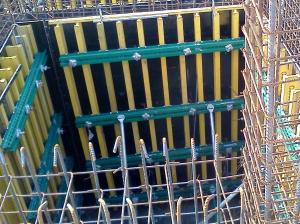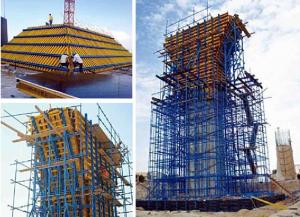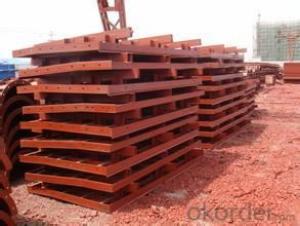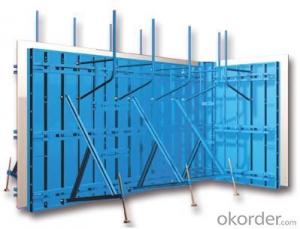Tabel Formwork for formwork and scaffolding system
- Loading Port:
- Tianjin
- Payment Terms:
- TT OR LC
- Min Order Qty:
- 50 m²
- Supply Capability:
- 1000 m²/month
OKorder Service Pledge
Quality Product, Order Online Tracking, Timely Delivery
OKorder Financial Service
Credit Rating, Credit Services, Credit Purchasing
You Might Also Like
Tabel Formwork:
Table formwork is the most typical application for slab, with timber beam, the slab formwork is
light weight, fast and economic in the construction.
Characteristics:
◆ Simple structure, easy assembly.
◆ Flexible structure, be adapted to different support system.
◆ High construction efficiency with special system tools.
1. Lifting fork for lifting the table formwork to upper floor.
2. Trolley for moving the table formwork on floor.
◆ Flexible application with stand alone props.
◆ Safer condition with handrails.
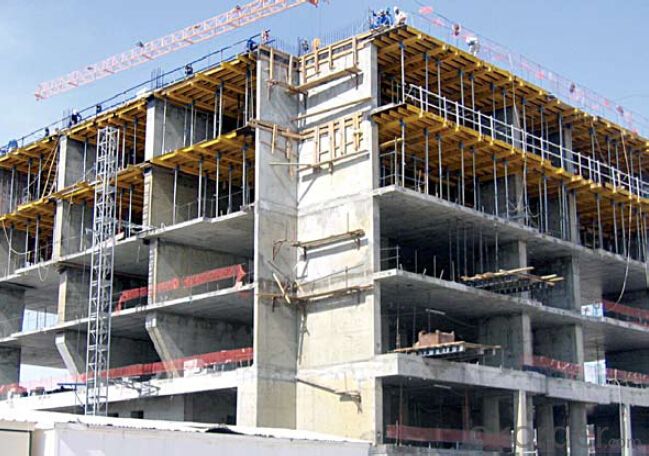
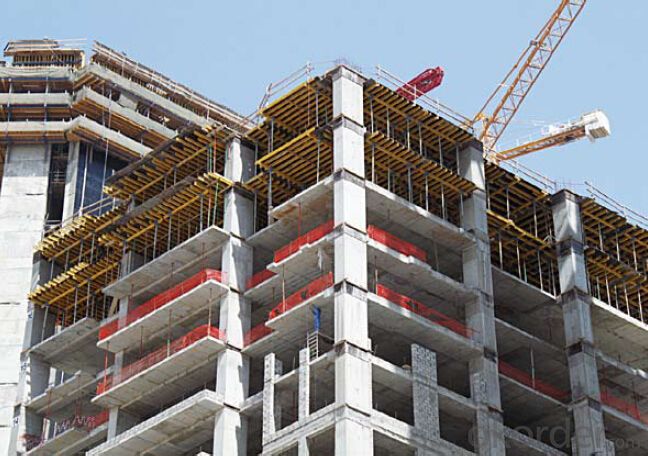

- Q:How does steel frame formwork handle the placement of decorative elements and finishes within the concrete structure?
- Steel frame formwork is a versatile system that allows for precise placement of decorative elements and finishes within the concrete structure. The rigid and adjustable nature of the steel frame enables accurate positioning and alignment of the decorative elements during the pouring and curing process. This ensures that the desired design features, such as patterns, textures, and shapes, are seamlessly integrated into the final concrete structure. Additionally, the steel frame provides stability and support, allowing for the creation of intricate and complex decorative finishes.
- Q:How does steel frame formwork compare to fiberglass formwork?
- Steel frame formwork and fiberglass formwork are both popular choices for construction projects, but they have distinct differences in terms of material composition, durability, and cost. Firstly, steel frame formwork is made of steel frames and plywood panels. This combination provides high strength and stability, making it suitable for heavy-duty applications. The steel frames can withstand heavy loads and offer excellent support for concrete pouring. Additionally, the plywood panels have high reusability, allowing for multiple uses in different projects. On the other hand, fiberglass formwork is made of reinforced fiberglass panels. This material is lightweight, yet still durable, offering advantages in terms of easier handling and transportation. The fiberglass panels are also resistant to various environmental factors such as water, chemicals, and UV radiation. This makes fiberglass formwork ideal for projects with specific requirements, such as those in coastal areas or in corrosive environments. In terms of durability, steel frame formwork is generally considered more resistant to wear and tear. Steel frames have a longer lifespan and can withstand rough handling and extreme weather conditions. They are also less prone to deformation and can be easily repaired or modified if needed. Fiberglass formwork, while durable, may be more susceptible to damage if mishandled or exposed to excessive force. However, proper care and maintenance can extend the lifespan of both types of formwork. Cost is another factor to consider when comparing steel frame formwork to fiberglass formwork. Steel frame formwork tends to be more expensive initially, as it requires the purchase of steel frames and plywood panels. However, due to its high reusability, the overall cost per project may be lower in the long run. Fiberglass formwork, while cheaper upfront, may need to be replaced more frequently, leading to higher overall costs over time. In conclusion, steel frame formwork and fiberglass formwork have their own advantages and disadvantages. Steel frame formwork offers high strength, stability, and durability, making it suitable for heavy-duty applications. Fiberglass formwork, on the other hand, is lightweight, resistant to environmental factors, and more cost-effective initially. Ultimately, the choice between the two will depend on the specific project requirements, budget constraints, and expected lifespan of the formwork.
- Q:How does steel frame formwork handle the placement of fire protection materials within the concrete structure?
- Steel frame formwork provides a highly efficient and effective solution for the placement of fire protection materials within concrete structures. The steel frame formwork system consists of modular panels and frames that are assembled to create a temporary structure for pouring and shaping the concrete. When it comes to fire protection, steel frame formwork allows for easy and precise installation of fire protection materials such as fireproofing coatings or fire-resistant boards. These materials can be applied directly to the surface of the steel frame formwork panels before the concrete is poured. The steel frame formwork system is designed to withstand the high temperatures that occur during a fire. It acts as a barrier, protecting the underlying concrete structure from the direct heat and flame exposure. Additionally, the steel frame formwork system provides structural integrity to the concrete, ensuring that it remains stable and intact even under fire conditions. Furthermore, steel frame formwork allows for flexibility in the placement of fire protection materials. Different areas of the concrete structure may require varying levels of fire resistance, and the modular nature of steel frame formwork allows for easy customization and adjustment to meet these specific requirements. In summary, steel frame formwork handles the placement of fire protection materials within the concrete structure by providing a stable and secure temporary structure for pouring and shaping the concrete. It allows for precise installation of fire protection materials, offers structural integrity and protection against high temperatures, and allows for flexibility in meeting specific fire resistance requirements.
- Q:What are the key quality control measures for steel frame formwork installation?
- There are several key quality control measures that should be followed for steel frame formwork installation. These measures are crucial to ensure the structural integrity and safety of the formwork system. 1. Proper inspection: Before starting the installation process, it is important to thoroughly inspect the steel frame formwork. This includes checking for any damages, defects, or missing components. Any issues should be addressed and resolved before proceeding with the installation. 2. Accurate alignment: The steel frame formwork should be properly aligned to ensure that it fits together seamlessly and provides a stable structure. This includes checking the vertical and horizontal alignment of the components, as well as ensuring that they are level and plumb. 3. Secure connections: The connections between the steel frame formwork components should be secure and tight. This can be achieved by using appropriate fasteners, such as bolts or screws, and ensuring that they are properly tightened. Loose connections can lead to instability and compromise the integrity of the formwork system. 4. Level and flat surfaces: The surfaces of the steel frame formwork should be level and flat to provide a stable and uniform support for the concrete. This can be achieved by using leveling tools, such as spirit levels or laser levels, to ensure that the formwork is properly aligned and adjusted. 5. Reinforcement placement: If reinforcement bars are required in the formwork system, they should be properly placed and secured. This includes ensuring that the bars are correctly positioned and adequately supported to prevent displacement during the concrete pouring process. 6. Adequate bracing: Steel frame formwork should be adequately braced to provide stability and prevent any deformation or collapse. This can be achieved by using diagonal braces or stiffeners, as well as ensuring that all bracing components are properly secured and tightened. 7. Regular inspection and maintenance: Throughout the installation process, regular inspections should be conducted to identify any potential issues or defects. Any damages or defects should be repaired or replaced immediately to ensure the safety and effectiveness of the formwork system. By following these key quality control measures, the steel frame formwork installation can be carried out efficiently and effectively, resulting in a robust and reliable structure for concrete casting.
- Q:Does steel frame formwork require any specific curing methods?
- No, steel frame formwork does not require any specific curing methods as it is primarily used for providing structural support during construction rather than for curing concrete.
- Q:How does steel frame formwork handle the construction of suspended slabs and beams?
- Steel frame formwork is a versatile and efficient method for handling the construction of suspended slabs and beams. This construction technique involves the use of a steel frame that is specifically designed to support and hold the concrete in place during the pouring and curing process. One of the key advantages of steel frame formwork is its strength and durability, which makes it ideal for supporting the weight of suspended slabs and beams. The steel frame is able to withstand the pressure and weight of the concrete, ensuring that the structure remains stable and secure throughout the construction process. Furthermore, steel frame formwork offers flexibility in terms of design and customization. It can be easily adjusted and modified to meet the specific requirements of different slab and beam configurations. This means that contractors have the ability to create unique and complex designs without compromising on structural integrity. In addition, steel frame formwork provides a smooth and even surface finish, resulting in high-quality and aesthetically pleasing slabs and beams. The formwork system is designed to prevent any leakage or seepage of the concrete, ensuring that the end result is a durable and visually appealing structure. Moreover, steel frame formwork offers faster construction times compared to traditional methods. The pre-fabricated steel frames can be easily assembled and disassembled, allowing for efficient installation and removal. This reduces the overall construction time and increases productivity on the construction site. Overall, the use of steel frame formwork for suspended slabs and beams provides numerous benefits, including strength, durability, flexibility, and efficiency. It is a reliable and cost-effective construction technique that is widely used in the industry.
- Q:How does steel frame formwork handle concrete pouring in rainy weather conditions?
- Steel frame formwork is a highly reliable and sturdy construction system that can effectively handle concrete pouring even in rainy weather conditions. The steel frame is designed to provide strong support and stability to the formwork, ensuring that it can withstand the pressure and weight of the wet concrete. In rainy weather, the steel frame formwork is generally covered with a waterproof membrane or tarp to protect the concrete from direct contact with water. This helps prevent the concrete from becoming diluted or washed away by the rain, which can compromise the quality and strength of the structure. Additionally, steel frame formwork is built with tight joints and connections, minimizing the risk of water seepage into the formwork. This helps maintain the integrity and shape of the concrete during the pouring process. The steel frame also provides a rigid structure that prevents any deformation or movement of the formwork, ensuring that the concrete is poured accurately and evenly. Moreover, the steel frame formwork system is designed with proper drainage channels and outlets to divert any excess water away from the concrete. This helps prevent water accumulation and ensures that the concrete sets properly without any water-related issues such as voids or weak spots. Overall, steel frame formwork is a reliable choice for concrete pouring in rainy weather conditions. Its robust construction, waterproofing measures, and efficient drainage system help maintain the quality and integrity of the concrete, ensuring a successful and durable construction project.
- Q:Can steel frame formwork be used in areas with limited space for storage?
- Yes, steel frame formwork can be used in areas with limited space for storage. Steel frame formwork is known for its versatility and compactness, making it suitable for projects with limited storage space. Unlike traditional formwork systems, steel frame formwork can be easily dismantled and reassembled, allowing for efficient use of storage space. Additionally, steel frame formwork is lightweight and easy to transport, further enhancing its suitability for areas with limited storage capacity. Overall, steel frame formwork is a practical and adaptable solution for construction projects in confined spaces.
- Q:Can steel frame formwork be used for both rectangular and irregularly shaped concrete elements?
- Yes, steel frame formwork can be used for both rectangular and irregularly shaped concrete elements. The adjustable nature of steel frame formwork allows it to be easily modified and customized to fit different shapes and sizes, making it suitable for various concrete structures.
- Q:How does steel frame formwork provide support to the concrete structure?
- The construction technique known as steel frame formwork utilizes steel frames to support the concrete structure while it is being poured and set. These steel frames are specifically designed to withstand the weight and pressure of the wet concrete, ensuring that the structure retains its shape and remains intact. Typically, the steel frames consist of durable steel beams, columns, and braces that are interconnected to create a rigid and stable framework. This framework acts as a temporary mold or template, holding the liquid concrete in place until it solidifies and gains strength. One of the main advantages of steel frame formwork is its ability to provide support and stability to the concrete structure, even in challenging construction scenarios. The steel frames can be easily adjusted and customized to accommodate structures of different shapes and sizes, making it a versatile solution for various construction projects. During the pouring process, the steel frame formwork is carefully positioned and secured. It is then filled with the wet concrete mixture, which fills all the empty spaces within the frame. The steel frames prevent the concrete from spreading or distorting under its own weight, ensuring that it maintains the desired shape and dimensions. As the concrete sets and hardens, the steel frames continue to provide support and prevent any movement or distortion. This is crucial in ensuring that the structure achieves the desired strength and durability. Once the concrete has fully cured, the steel frame formwork can be removed, leaving behind a solid and well-supported concrete structure. In conclusion, steel frame formwork is an essential component in supporting the concrete structure during the pouring and setting process. It guarantees that the concrete maintains its shape and integrity, ultimately contributing to the strength and durability of the finished structure.
1. Manufacturer Overview |
|
|---|---|
| Location | |
| Year Established | |
| Annual Output Value | |
| Main Markets | |
| Company Certifications | |
2. Manufacturer Certificates |
|
|---|---|
| a) Certification Name | |
| Range | |
| Reference | |
| Validity Period | |
3. Manufacturer Capability |
|
|---|---|
| a)Trade Capacity | |
| Nearest Port | |
| Export Percentage | |
| No.of Employees in Trade Department | |
| Language Spoken: | |
| b)Factory Information | |
| Factory Size: | |
| No. of Production Lines | |
| Contract Manufacturing | |
| Product Price Range | |
Send your message to us
Tabel Formwork for formwork and scaffolding system
- Loading Port:
- Tianjin
- Payment Terms:
- TT OR LC
- Min Order Qty:
- 50 m²
- Supply Capability:
- 1000 m²/month
OKorder Service Pledge
Quality Product, Order Online Tracking, Timely Delivery
OKorder Financial Service
Credit Rating, Credit Services, Credit Purchasing
Similar products
New products
Hot products
Related keywords




















